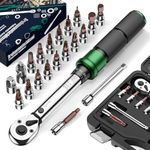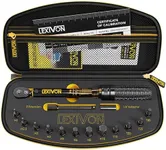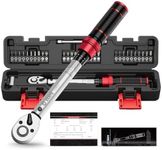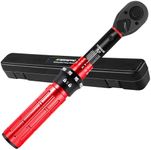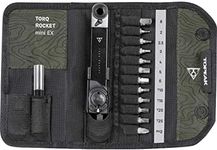Buying Guide for the Best Torque Wrench For Bicycle
Choosing the right torque wrench for your bicycle is crucial for ensuring that all the components are tightened to the manufacturer's specifications, preventing damage and ensuring safety. A torque wrench allows you to apply a specific amount of force to a bolt or nut, which is essential for modern bicycles that often use lightweight materials. When selecting a torque wrench, consider the type of work you will be doing on your bike, the range of torque settings you need, and the ease of use of the tool.Torque RangeThe torque range of a wrench indicates the minimum and maximum force it can apply. This is important because different parts of a bicycle require different torque settings. For example, carbon components often need lower torque settings to avoid damage, while other parts like bottom brackets may require higher settings. Torque wrenches typically come in ranges like 2-20 Nm, 5-25 Nm, or 10-60 Nm. If you primarily work on lightweight components, a lower range like 2-20 Nm might be suitable. For more general use, a mid-range wrench like 5-25 Nm could be ideal.
Type of Torque WrenchThere are several types of torque wrenches, including beam, click, and digital. Beam wrenches are simple and reliable but can be harder to read. Click wrenches are popular for their ease of use, as they produce a 'click' sound when the set torque is reached. Digital wrenches offer precision and often have features like memory settings but can be more expensive. If you value simplicity and reliability, a beam wrench might be best. For ease of use, a click wrench is a good choice, while a digital wrench is ideal for those who want precision and additional features.
AccuracyAccuracy is crucial in a torque wrench to ensure that you are applying the correct amount of force. Most quality torque wrenches have an accuracy of +/- 4% or better. This means that the actual torque applied will be within 4% of the setting. Higher accuracy is important for delicate components, especially on high-end bicycles. If you are working on expensive or sensitive parts, look for a wrench with higher accuracy. For general maintenance, a standard accuracy level should suffice.
Size and Handle ComfortThe size and comfort of the handle can affect how easy the wrench is to use. A comfortable grip is important for applying torque accurately and for reducing fatigue during longer maintenance sessions. Torque wrenches come in various sizes, and a longer handle can provide more leverage, making it easier to apply higher torque settings. If you have smaller hands or prefer a lighter tool, look for a wrench with a smaller handle. For those who need to apply higher torque, a longer handle might be more suitable.
CalibrationCalibration ensures that the torque wrench is providing accurate readings. Over time, wrenches can lose their calibration, leading to inaccurate torque application. Some wrenches come with a certificate of calibration, and it's important to recalibrate them periodically, especially if they are used frequently. If you plan to use the wrench often, consider one that is easy to recalibrate or comes with a calibration service. For occasional use, a wrench with a good initial calibration should be sufficient.

